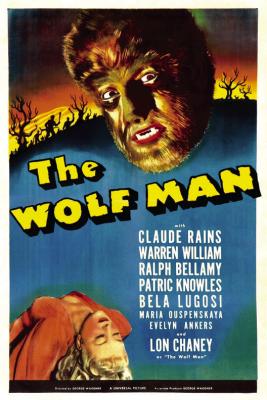The Legacy of The Wolf Man
Comically Serious
Marvel has recently released their Halloween special: Werewolf By Night. This special homages the classic Universal horror cycle of films, in particular, The Wolf Man from 1941. So in honor of the release, let’s take a look at the movie that captured the imagination of audiences and shaped the popular perception of a werewolf.
While The Wolf Man wasn’t the first werewolf movie, The Wolf Man is responsible for many of the tropes we associate with the creature.
The film tells the story of Larry Talbot played by Lon Chaney Jr., who would go on to become Universal’s most prolific actor for playing monsters (having also been Count Alucard, the Frankenstein’s Monster and the mummy Kharis).
Larry returns to his ancestral home in Llanwelly, Wales from the United States following the death of his brother. Larry takes time to reconcile with his father Sir John Talbot (Claude Rains), and meets a local girl named Gwen Conliffe (Evelyn Ankers) at an antique shop. While there, Larry purchases a cane with a silver wolf’s head and learns the legend of the werewolf, and that they see a pentagram on the palm of their next victim. Larry also learns a poem recited by villagers that is mentioned throughout the film: “Even a man who is pure in heart, and says his prayers by night; May become a wolf when the wolfsbane blooms and the autumn moon is bright.”
Larry joins Gwen and a friend of her’s to have their fortunes told. The Romani reading Jenny’s fortune, Bela (played by Dracula himself: Bela Lugosi), sees the pentagram in her palm and soon becomes a werewolf. The werewolf Bela kills Jenny, as Larry arrives and kills the werewolf, but is bit by Bela. Soon Larry finds himself turning into a werewolf as well.
There was a lot of discussion during the production of this movie over whether Talbot would actually turn into a werewolf or if it would all be in his head. The final product can be read either way to a point, but it is very apparent that the transformation is real in the setting of the film.
Speaking of transformation, the process was extremely laborious. Lon Chaney Jr. was forced to sit motionless for hours as Jack Pierce (the monster makeup guy himself) would apply the makeup which consisted of grease paint, a rubber snout appliance, a series of wigs and gluing layers of yak hair to Chaney’s face.
The results, however, speak for themselves as this is arguably some of Pierce’s best work and right up there with the makeup from the Frankenstein Monster.
Despite being the classic werewolf movie, you may be surprised to learn that this film doesn’t feature a shot of the full moon or an on-screen facial transformation from man to wolf. In fact, by the film’s internal logic, a full moon is unnecessary for the transformation to occur and instead implies that a werewolf will turn on every night in autumn.
The film has an incredibly gothic quality with the heavy use of foggy forests that is enhanced by a really atmospheric score (one that was so good in fact, Universal would recycle it in several other films).
The Wolf Man would launch Lon Chaney Jr. into popularity and he would return in the role for four more films in Frankenstein Meets the Wolf Man, House of Frankenstein, House of Dracula, and Abbot and Costello Meet Frankenstein.
This is my favorite of the Universal Horror films and is just a fantastic movie overall. As mentioned above, this movie had a tremendous impact on the perception of werewolves in the pop cultural collective consciousness as tragic victims of their conditions.
I highly recommend checking this one out and witnessing a piece of influential cinema.



